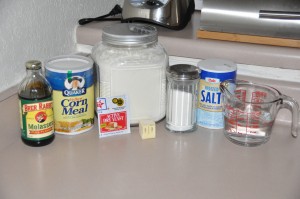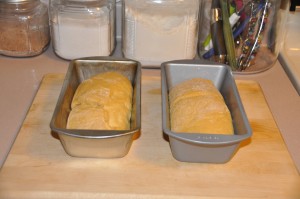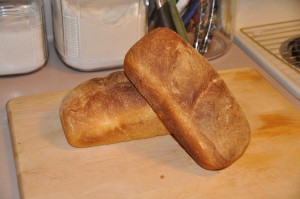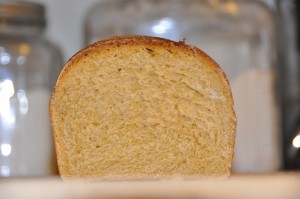“There are many recipes for this famous American loaf. No two people agree on what the original was, but it is practically certain that it contained cornmeal and molasses.”
-James Beard, Beard on Bread
I have never heard of Anadama Bread, despite its alleged status as a “famous American loaf.” I checked the Wikipedia article, and apparently it is an old New England recipe; however, my Maine-raised husband hadn’t heard of it either. According to legend, there was a woman named Anna who cooked nothing but cornmeal mush with molasses for her husband. One day, he added yeast and flour to his porridge and baked it, cursing “Anna, damn her!” as he ate the bread. My thought is that if Anna’s husband could bake bread, he should have spent more time doing that and less time complaining about his wife’s cooking.
Whether or not it’s famous, Anadama Bread was a welcome change from Apricot Bread. Mike ended up taking most of that to work yesterday. He reported that it was completely gone by noon. Apparently there are lots of people who do not share my white-hot hatred for apricots.
Here are the ingredients, including the signature ingredients of cornmeal and molasses:
Mindful of the near-disaster that resulted when I didn’t add enough flour to my Cornmeal Bread, I erred on the side of caution and accidentally added too much flour. I was able to get my dough to the right consistency by kneading in a half teaspoon of water. The dough seemed much tougher than previous doughs I’ve worked with, possibly due to the cornmeal.
I let the dough rise for 1 hour and 45 minutes and then formed it into loaves in 8 x 4 pans. Then, I let the loaves rise for an hour.
After baking the loaves at 425 degrees for 10 minutes, I turned the oven down to 350 degrees and baked them for 20 minutes. I always use the “thump test” to check for doneness: I tap the top of the loaf with a table knife, and if if sounds hollow, I turn the bread out of the pan and tap the bottom. If that sounds hollow as well, the bread is done.
Anadama Bread was infinitely better than Apricot Bread. It is a slightly salty, finely textured bread, with a rich, savory flavor from the molasses. Mike referred to it as “a manly bread” because he thought it was especially hearty. I feel fortunate to have a husband who is so appreciative of all of my baking efforts–unlike poor Anna!




